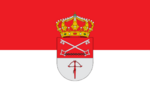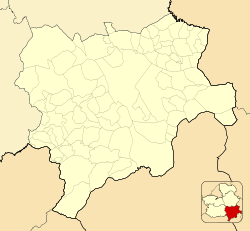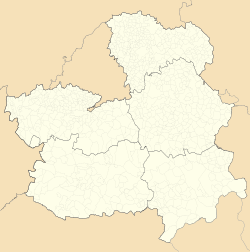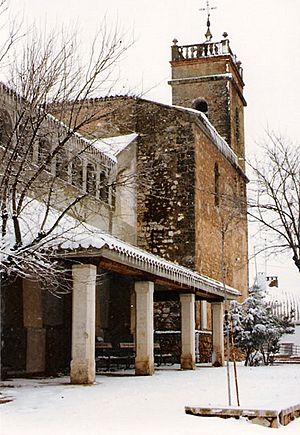El Ballestero facts for kids
Quick facts for kids
El Ballestero
|
|||
|---|---|---|---|
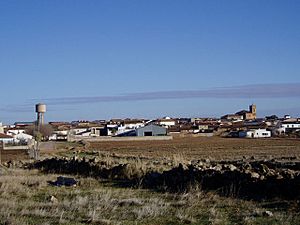 |
|||
|
|||
| Country | |||
| Autonomous Community | |||
| Province | |||
| Comarca | Campo de Montiel | ||
| Area | |||
| • Total | 138.69 km2 (53.55 sq mi) | ||
| Elevation | 1,029 m (3,376 ft) | ||
| Population
(2018)
|
|||
| • Total | 409 | ||
| • Density | 2.949/km2 (7.638/sq mi) | ||
| Area code(s) | 967 38 40 | ||
El Ballestero is a small town in Albacete, Castilla–La Mancha, Spain. It is about 68 kilometers (42 miles) west of the city of Albacete. The town is known for its quiet charm and interesting history.
The name "Ballestero" comes from the Spanish word for "crossbowman." Local stories say the area was settled by crossbowmen. This happened after a meeting between King Alfonso X and King Jaime I of Aragón. They met to decide who owned the land after a war. The town grew around a main road that connected the towns of Munera and Robledo.
Like many small towns in La Mancha, El Ballestero saw its population shrink. In the mid-1900s, many people moved away. For example, in 1964, over 500 people left. They often went to bigger cities or the coast. There were more job opportunities there, especially in the growing tourism industry. Recently, many old, empty houses have been bought. People from cities like Madrid and Valencia are fixing them up as second homes. This has greatly reduced the number of ruined houses in the town.
Contents
What's in El Ballestero?
El Ballestero has several useful places for its residents and visitors.
Buildings and Shops
- An old church from the 1700s, built in the Renaissance style.
- Two bars where you can get food.
- A supermarket for groceries.
- A pharmacy for medicines.
- A bread shop for fresh bread.
- A hairdresser.
- A public library.
- A bank.
- A school for local children.
Fun and Leisure
- An Olympic-sized swimming pool. It's open to everyone in July and August.
- A music bar that opens on weekends.
- A small market held every Thursday.
- Several guest houses (called casas rurales) and a small hotel for visitors.
How El Ballestero Makes Money
The main way people in El Ballestero earn a living is through farming. They mostly raise lambs and grow wheat and barley.
There is also a large factory in town. This factory makes embutidos, which are types of cured meats like sausages and hams.
El Ballestero is also home to many wind turbines. These tall structures use wind to create electricity. In June, when crops are harvested, the countryside looks like a wide, open prairie. The area also has a special type of juniper tree called Juniperus sabina. These trees grow slowly and are now protected, so their numbers are starting to increase.
Exploring El Ballestero and Nearby
El Ballestero is part of the Ruta de Don Quijote. This is a famous route named after the fictional hero Don Quixote.
Places to Visit Nearby
- Libisosa: The remains of an ancient Roman town near Lezuza.
- Alcaraz: A historic town from the Middle Ages.
- Las Lagunas de Ruidera: A beautiful group of lakes.
- The Sierra de Alcaraz: A mountain range where you can find lots of wildlife.
- El Santuario de Nuestra Señora de Cortes: A nearby religious sanctuary.
Ancient Paths and History
Not only did Don Quixote's story pass through here, but also Hannibal. He was a famous general from Carthage who almost conquered Rome. He traveled near the town on a very old track. This ancient road was later rebuilt by the Romans. About 800 meters (half a mile) of it are still in good condition north of El Ballestero.
Another old path is the Cañada Real de Los Serranos. This was part of a network of medieval cattle tracks across Spain. It runs slightly further north of the town.
Weather in El Ballestero
El Ballestero is about 1,029 meters (3,376 feet) above sea level. This high elevation affects its weather.
Summer
In summer, the days can be very hot, much hotter than on the coast. However, because of the high elevation, the nights stay cool. This makes it a popular place for people from the coast and Madrid. Many of them have second homes here and visit in July and August.
Autumn
In autumn, the town is popular with hunters. There are many hares, rabbits, and partridges in the area.
Winter
In winter, temperatures can drop below freezing. It often snows several times a year. The snow usually melts after a few days.
Local Celebrations
The main local festivals are for San Lorenzo on August 10th and San Miguel on September 29th.
The Tradition of Virgen de la Encarnación
A special tradition in El Ballestero is the Virgen de la Encarnación. This celebration happens on Whitsunday and the Feast of St Michael. It remembers events from about 400 years ago.
The Story Behind the Tradition
Long ago, in the 1600s, a serious illness spread in Villalgordal. This was a small village about 14 kilometers (9 miles) south of El Ballestero. The illness caused most of the villagers to die. After it ended, the people who survived decided to burn down their village for health reasons. They then moved to nearby towns. Most of them came to El Ballestero.
They brought with them their statue of the "Virgen de la Encarnación." This is a statue of the Virgin Mary, a little smaller than life-size. They placed it in the church in El Ballestero.
Whitsunday Procession
Every Whitsunday, the villagers gather. They carry the Virgin statue along an old track. They go to the original site of Villalgordal. Today, this is just a stony field with a small, restored chapel. The chapel overlooks a river.
Once they reach Villalgordal, the Virgin is placed back in her original home in the chapel. A special church service is held. After the service, the town provides a meal for everyone who participated or watched. Then, the chapel is locked, and the townspeople return home.
Fiesta de San Miguel
On September 29th, during the Fiesta de San Miguel, another church service takes place at Villalgordal. After another meal, the statue is carried back to El Ballestero. People meet her at the town entrance with decorated floats showing local life. She is then escorted back to the church. Bonfires are lit to celebrate her return. The celebration ends with a firework display.
The statue stays in the church during the winter. The next year, she is returned to her summer chapel. This tradition has continued for about 400 years.
See also
 In Spanish: El Ballestero para niños
In Spanish: El Ballestero para niños


